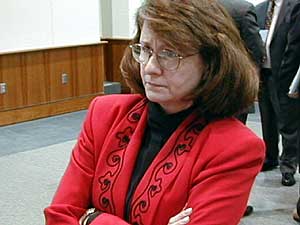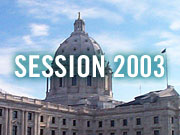K-12 spared, but higher ed cut more deeply
February 18, 2003
 |
| Education Commissioner Cheri Pierson Yecke (MPR Photo/Tim Pugmire) |
St. Paul, Minn. — Gov. Pawlenty's proposed budget includes $12.6 billion for pre-kindergarten through 12th grade education. That's a 17 percent increase from the last state budget, or about $1.9 billion. But about $1 billion is related to the 2001 shift of basic school funding from local property taxes to the state budget. The Republican governor still boasted that overall, per-pupil K-12 spending would increase by 2.2 percent next year, and 1.3 percent the year after.
"In the interest of fair and full disclosure, this is total revenues in terms of state committment to K-12 education and levies," Pawlenty said.
 | |||
Take away the local levy money, and those per-pupil increases shrink to just a fraction of one percent next year, and no change the following year.
The governor's budget also adjusts the state's funding formulas to slow the growth of spending earmarked for high poverty schools, immigrant students, adult education and special education. But special "transition revenue" would prevent school districts from losing any financial ground for at least one year.
Pawlenty is also counting on teachers and other school district employees to accept a two-year wage freeze.
 | |||
"We cannot afford to hold school districts flat, and then have school boards give everybody a cost of living adjustment and a step and lane adjustment, which they get on the salary schedules, and have their health insurance go up 20 percent, and then go back and cannibalize programs. We can't do that," Pawlenty said.
The state teacher's union does not appear ready to give up on collective bargaining. Judy Schaubach, president of Education Minnesota, says a wage freeze would make it harder for districts to attract and retain quality teachers.
"Everybody is willing to do their part, but it isn't right to have just one segment of the working force absorb this," said Schaubach.
Higher education officials were expecting to do their part in the budget balancing solution, but they say Pawlenty's budget proposal is more painful than expected. The governor's plan proposes $2.5 billion for higher education, a 9 percent decrease from current spending. But state appropriations to the University of Minnesota and the Minnesota State Colleges and Universities system are reduced by 15 percent. That means $185 million less for the U of M and a $204 million cut for MnSCU.
U of M president Bob Bruininks says the reductions will require painful and difficult decisions across the university.
"These decisions will have an impact on thousands of real people -- our faculty, staff, and students, and their families. It will simply not be business as usual at the University of Minnesota," Bruininks said.
The governor's proposal also limits MnSCU tuition increases to 15 percent and recommends the same for the U of M. MnSCU Chancellor James McCormick says a tuition cap limits the budget options.
"Now we're still not sure whether he means a one-time 15 percent increase or a 15 percent increase per year. But a one-time 15 percent tuition increase would produce about $110 million in revenue over the biennium, leaving a gap of $94 million," McCormick said.
The budget plan increases funding for the state grant program by $60 million. That money can help students attend public or private colleges. Pawlenty says increasing financial aid will minimize the impact of budget cuts on students.
"And in the meantime it's reform. You're providing more competition in the marketplace, and it will force institutions to compete more vigorously for those students. That's a good thing," said Pawlenty.
The governor's higher education budget proposal also changes the method of funding for the University of Minnesota's Academic Health Center. The state would earmark 6.5 cents per pack of the current cigarette tax for the medical schools, rather than using the state tobacco endowment. Pawlenty also formally proposes the Department of Children, Families and Learning be renamed the Department of Education, and calls for a $7.5 million decrease in its operational budget.
|
News Headlines
|
Related Subjects
|

